How it is made: radiometer, nitratomer and other sensors for iPhone
By order of the American startup Lapka, we developed a case design, selected materials and produced prototypes of four sensors for Apple mobile devices: a radiometer, a nitratomer, moisture meters and electromagnetic fields.
These sensors connect to the standard iPhone, iPad or iPod audio connector, use their power and processor, analyze the data obtained from the measurements, and display the results in the interface of a free iOS application.
In this article, we want to share our experience and tell Habr's readers about the project implementation.
')
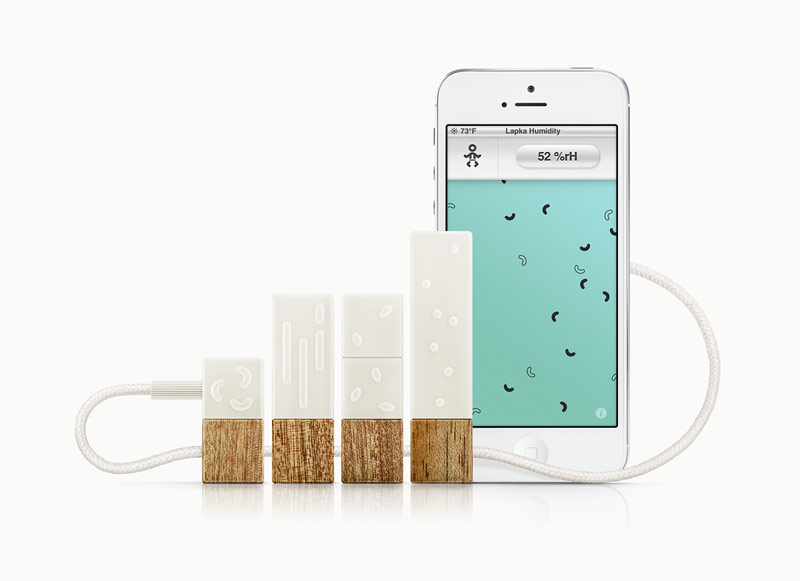
The authors of the project, Vadik Marmeladov and Sergey Fillipov, set a goal to unite the style of Yves Saint Laurent with NASA technologies. They developed the design concept and the Lapka software and hardware stuffing, and they entrusted us with the tasks of designing the case, choosing materials and prototyping us, the specialists of the independent electronics design center Promwad .
In the first photo - a ready-made set of devices - the result of our joint efforts. But let's see, from what and how all this is done.
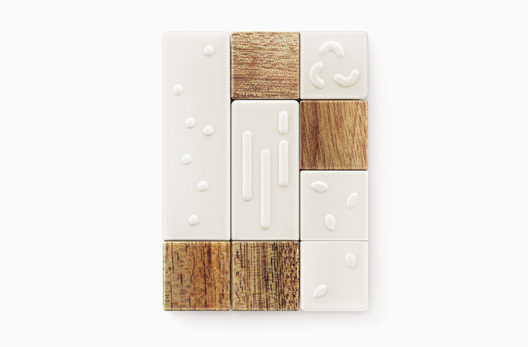
In the photo (from left to right): Lapka sensors to determine the level of radiation, electromagnetic radiation, the amount of nitrates in vegetables and fruits and the level of humidity (the smallest sensor at the top). The source of all the illustrations for the article: https://mylapka.com .
We got at our disposal detailed information on how finished devices should look like: design sketches, requirements for materials, colors, etc. Our task is to translate these wishes into a real device.
Each Lapka sensor is a plastic block with a wooden base in which a hole is made for the wire, the proportions of all the elements are built on a cube with a 19 mm face.
When choosing plastic, we established the following criteria: white matte color, high density and pleasant tactile sensations. The material should be associated with ivory, because one of the features of the project Lapka, its competitive advantage is an unusual design.
As a rule, the developers of measuring equipment do not pay special attention to the aesthetic solution of the body, since for them, the main thing is ergonomics and functionality. We must emphasize not only modern technical stuffing, but also a special style of sensors. They should be for the user not just a useful accessory, but a kind of decoration, a talisman to protect against the dangers of the surrounding world.
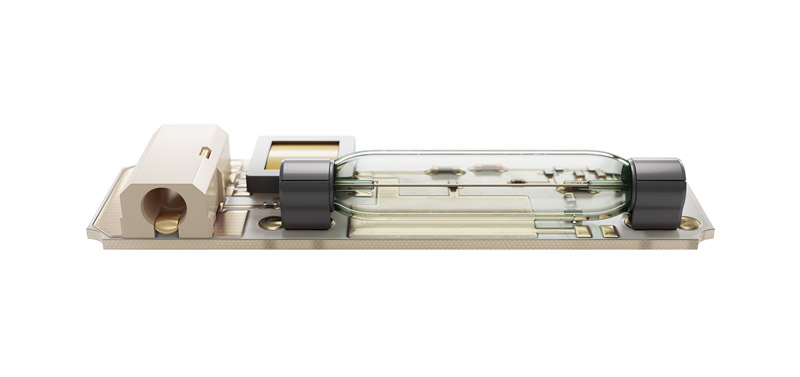
In the photo: a miniature Geiger-Müller CJ32 counter (hard beta and gamma radiation detector) - technical stuffing of the Lapka radiometer.
It is important to take into account that the sensors are used in tandem with Apple mobile devices, which are distinguished by their proprietary design; this sets certain requirements for the quality of materials. Lapka devices should harmonize with the iPhone and iPad.
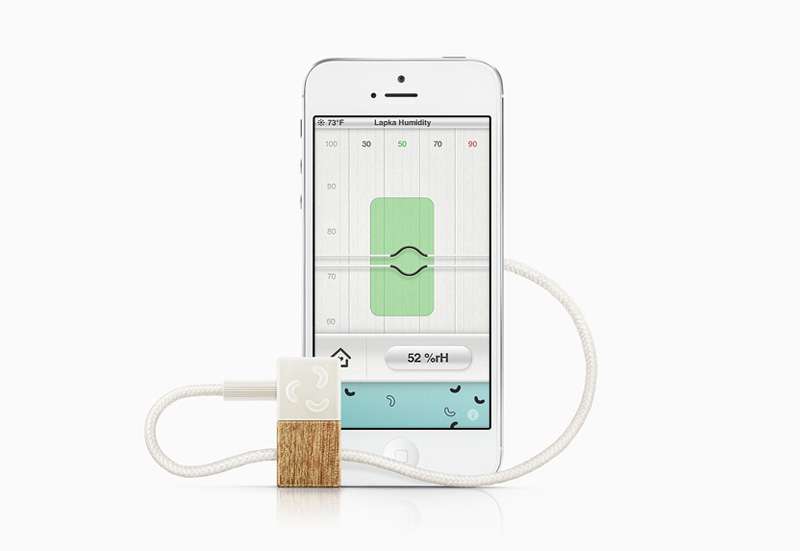
Photo: Lapka moisture meter
In accordance with the production technology, we selected 3 plastics with the necessary strength and light absorption / refraction indices in order to make the final choice at the stage of testing prototypes.
The selection of wood turned out to be an interesting task; we focused on hard rocks of a dark color. For the sake of appearance and pleasant tactile sensations, we had to abandon additional coverage, so the Lapka cube base is a living, polished wood, with its pleasant texture.
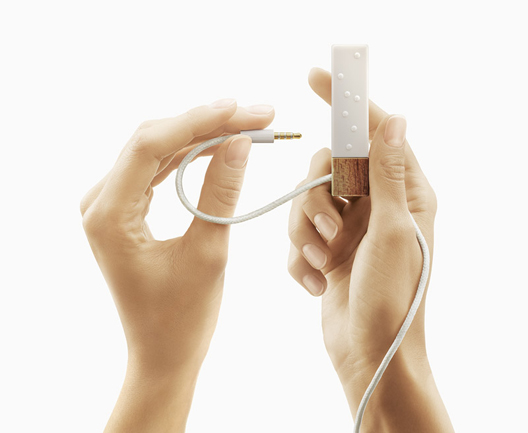
Photo: Lapka radiometer
The third material for Lapka sensors is metal, it is used for the probe of the nitrate meter, which interacts with the pulp and juice of vegetables and fruits. Accordingly, it should be resistant to aggressive media (various acids, etc.). Another feature - mounting the probe to the plastic case should be implemented without external fasteners. We chose two different grades of stainless steel - for the base of the probe and its working part.
Thus, the metal element adjacent to the housing of the nitratomer is made of steel with pronounced magnetic properties. We ensured its reliable fastening due to the permanent ring magnet in the case (pull-off force - 4 kg). The probe itself was made of a non-magnetic steel grade in order not to contact the magnet in the closed position of the device.

In the photo: Lapka plate and probe nitratomer
At this stage, we were engaged in 3D-modeling and the preparation of design documentation. It was necessary to think up a reliable internal fixation of the printed circuit boards of the sensors and take into account the casting slopes.
We paid special attention to the tightness of the nitratomer at the point of attachment of the probe so that no liquid would penetrate into the instrument. This problem was solved using high-flow plastics with high adhesion to metal.
We made the probe itself in a non-standard size so that the user mistakenly mistook him for the audio jack and did not connect to the Apple device. :)
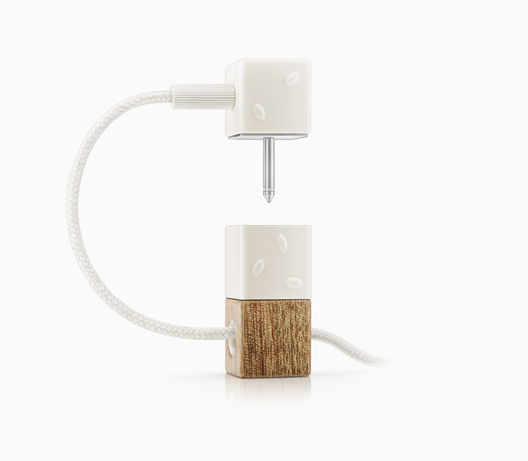
On the photo: Lapka nitratomer
One of the most exciting stages of the project was the manufacture of prototypes for us, we ordered several sets of devices using various materials, and then we tested them for durability, analyzed the appearance, the combination of colors and tactile sensations.
As a result, we stopped at the following combination of materials:
The result of our work was the production of the installation batch and a complete package of design documentation for mass production.
More detailed information on the implementation of this project is available in the Promwad portfolio .
& nbsp
These sensors connect to the standard iPhone, iPad or iPod audio connector, use their power and processor, analyze the data obtained from the measurements, and display the results in the interface of a free iOS application.
In this article, we want to share our experience and tell Habr's readers about the project implementation.
')

The authors of the project, Vadik Marmeladov and Sergey Fillipov, set a goal to unite the style of Yves Saint Laurent with NASA technologies. They developed the design concept and the Lapka software and hardware stuffing, and they entrusted us with the tasks of designing the case, choosing materials and prototyping us, the specialists of the independent electronics design center Promwad .
In the first photo - a ready-made set of devices - the result of our joint efforts. But let's see, from what and how all this is done.

In the photo (from left to right): Lapka sensors to determine the level of radiation, electromagnetic radiation, the amount of nitrates in vegetables and fruits and the level of humidity (the smallest sensor at the top). The source of all the illustrations for the article: https://mylapka.com .
1. Selection of materials for the body
We got at our disposal detailed information on how finished devices should look like: design sketches, requirements for materials, colors, etc. Our task is to translate these wishes into a real device.
Each Lapka sensor is a plastic block with a wooden base in which a hole is made for the wire, the proportions of all the elements are built on a cube with a 19 mm face.
When choosing plastic, we established the following criteria: white matte color, high density and pleasant tactile sensations. The material should be associated with ivory, because one of the features of the project Lapka, its competitive advantage is an unusual design.
As a rule, the developers of measuring equipment do not pay special attention to the aesthetic solution of the body, since for them, the main thing is ergonomics and functionality. We must emphasize not only modern technical stuffing, but also a special style of sensors. They should be for the user not just a useful accessory, but a kind of decoration, a talisman to protect against the dangers of the surrounding world.

In the photo: a miniature Geiger-Müller CJ32 counter (hard beta and gamma radiation detector) - technical stuffing of the Lapka radiometer.
It is important to take into account that the sensors are used in tandem with Apple mobile devices, which are distinguished by their proprietary design; this sets certain requirements for the quality of materials. Lapka devices should harmonize with the iPhone and iPad.

Photo: Lapka moisture meter
In accordance with the production technology, we selected 3 plastics with the necessary strength and light absorption / refraction indices in order to make the final choice at the stage of testing prototypes.
The selection of wood turned out to be an interesting task; we focused on hard rocks of a dark color. For the sake of appearance and pleasant tactile sensations, we had to abandon additional coverage, so the Lapka cube base is a living, polished wood, with its pleasant texture.

Photo: Lapka radiometer
The third material for Lapka sensors is metal, it is used for the probe of the nitrate meter, which interacts with the pulp and juice of vegetables and fruits. Accordingly, it should be resistant to aggressive media (various acids, etc.). Another feature - mounting the probe to the plastic case should be implemented without external fasteners. We chose two different grades of stainless steel - for the base of the probe and its working part.
Thus, the metal element adjacent to the housing of the nitratomer is made of steel with pronounced magnetic properties. We ensured its reliable fastening due to the permanent ring magnet in the case (pull-off force - 4 kg). The probe itself was made of a non-magnetic steel grade in order not to contact the magnet in the closed position of the device.

In the photo: Lapka plate and probe nitratomer
2. Development of a design of details of Lapka sensors
At this stage, we were engaged in 3D-modeling and the preparation of design documentation. It was necessary to think up a reliable internal fixation of the printed circuit boards of the sensors and take into account the casting slopes.
We paid special attention to the tightness of the nitratomer at the point of attachment of the probe so that no liquid would penetrate into the instrument. This problem was solved using high-flow plastics with high adhesion to metal.
We made the probe itself in a non-standard size so that the user mistakenly mistook him for the audio jack and did not connect to the Apple device. :)

On the photo: Lapka nitratomer
3. Production production: prototypes, tooling, installation batch
One of the most exciting stages of the project was the manufacture of prototypes for us, we ordered several sets of devices using various materials, and then we tested them for durability, analyzed the appearance, the combination of colors and tactile sensations.
As a result, we stopped at the following combination of materials:
- For the manufacture of plastic shells, polyoxymethylene (POM) was chosen, which is physiologically harmless, rigid, durable, resistant to shock loads, oils and organic solvents. Due to such properties, it is used as a substitute for metals and alloys in the automotive industry and prosthetic dentistry.
- For the wooden basis of the sensors, we chose the sapele - this kind of tree grows in Africa. By its properties, such wood is close to mahogany (the so-called “mahogany”), therefore it is often called African mahogany. This decorative material with a weak contrasting striped pattern lends itself well to machining and polishing, but at the same time it is quite hard. Parquet, furniture, electric guitars and other musical instruments are made from the sapele.
The result of our work was the production of the installation batch and a complete package of design documentation for mass production.
More detailed information on the implementation of this project is available in the Promwad portfolio .
& nbsp
Source: https://habr.com/ru/post/182394/
All Articles